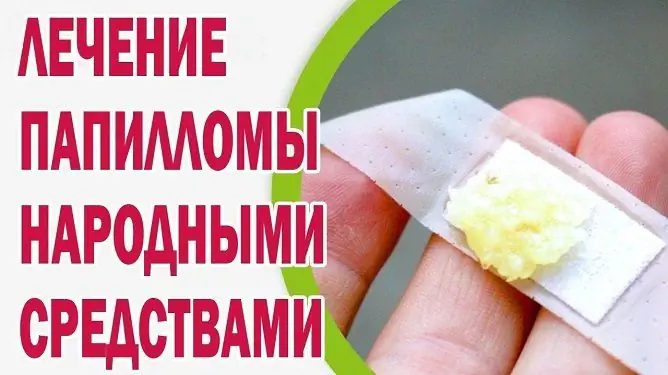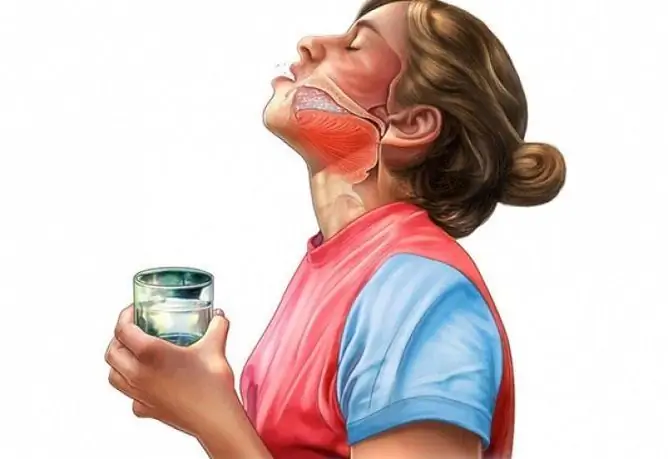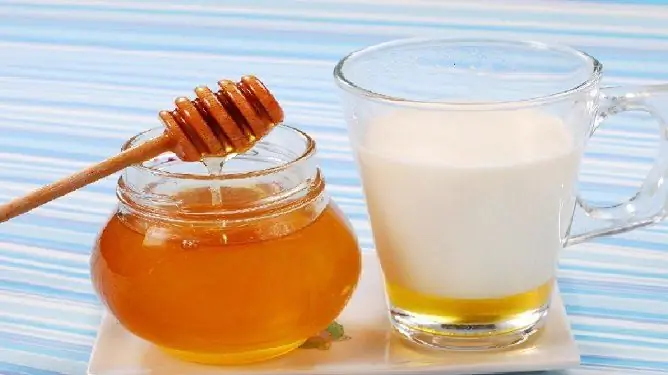- Author Rachel Wainwright [email protected].
- Public 2023-12-15 07:39.
- Last modified 2025-11-02 20:14.
Treatment of the consequences of a stroke with folk remedies
The content of the article:
-
The most effective and popular folk recipes for post-stroke recovery
- Pine cones
- Rosehip
- Sage and thyme
- Sophora Japanese
- Dioscorea Caucasian
- Jaundice gray
- Burdock
- Juniper
- Herbal preparations
- Citrus
- Honey
- Video
Treatment of the consequences of a stroke with folk remedies can provide significant benefits and reduce the drug load on the body. However, it should be borne in mind that any methods of traditional medicine should be used only after consulting a doctor as an addition to the main therapy. The statement that all of them are a priori, if not useful, then safe, is unfounded.
Stroke is a violation of blood circulation in the vessels of the brain, as a result of which oxygen starvation of the cells fed by these vessels develops.
There are two types of strokes: ischemic and hemorrhagic. In the first case, the vessel becomes clogged with a blood clot (thrombus) or an atherosclerotic plaque, due to which the blood flow through the vessel stops, and the area that it feeds is ischemic, that is, it is deprived of nutrition. In the second, the violation of blood flow through the vessel occurs due to its rupture, accompanied by hemorrhage. With proper and timely treatment, there are considerable chances for a favorable outcome, but often serious and long-term rehabilitation is needed to restore the functions lost as a result of brain damage.
Rehabilitation after a stroke and prevention of its relapse is aimed at activating blood microcirculation through the vessels of the brain, normalizing blood cholesterol levels, cleansing blood vessels and increasing their tone, reducing blood viscosity, and improving the transmission of nerve impulses.
To eliminate the severe consequences of acute disorders of cerebral circulation, a complex of restorative and therapeutic measures is used, including, in addition to taking medication, courses of physiotherapy exercises and massage, proper nutrition, physiotherapy procedures, classes with a speech therapist, training of mental abilities and fine motor skills, social and psychological adaptation.

In post-stroke rehabilitation, traditional medicine can be used, however, this is recommended only after consultation with the attending physician
Treatment of the consequences of a stroke with folk remedies allows:
- restore the conduction of nerve impulses and, in general, the work of the nervous system;
- stimulate the metabolism in the nervous tissue;
- increase blood flow to the cells of the brain, improve its blood supply;
- achieve a decrease in blood viscosity and improve microcirculation in the capillaries;
- prevent the formation of blood clots and the development of thromboembolism.
The most effective and popular folk recipes for post-stroke recovery
Herbs, fruits and roots of plants in the form of decoctions, tinctures or ointments are actively used to recover from a stroke.
Pine cones
The combination of vitamins and microelements, bioflavonoids, essential oils, phytoncides, tannins and other biologically active substances makes pine cones an indispensable remedy for restorative treatment. Pine cones contain tannin, which prevents the death of brain cells and promotes their recovery. Phytoncides tone up blood vessels, have an antimicrobial effect, bioflavonoids and other trace elements normalize blood cholesterol levels, and prevent the process of thrombus formation.
Tinctures and decoctions of young pine cones are among the most popular and effective folk remedies in the treatment of the effects of stroke.

To make medicines from pine cones, you should take green cones that have grown far from industrial facilities and highways.
Medicines are prepared from green buds that have not yet opened. It is better to collect young green cones in late summer - early autumn, at this moment the plant accumulates all the most useful substances. It is advisable to collect cones away from industrial facilities and highways; cones are torn from trees that are not damaged by pests and diseases. Store raw materials in a well-ventilated dry place.
To prepare the tincture, 5-6 cones are washed and cut into pieces. They fill a clean jar with them and pour 300 ml of alcohol or vodka. The solution should be placed in a dark place for 14 days and infused at a temperature of 18-20 C °, periodically shaking the container. The tincture should turn out to be a thick, dark red color. The finished tincture is filtered and taken after a stroke, one tablespoon 3 times a day. For the prevention of cardiovascular diseases, it is recommended to take the agent one tablespoon before breakfast. The minimum course of treatment of the consequences of a stroke with folk remedies in the form of decoctions and infusions from cones is three weeks, then a week break is taken, then the three-week course is repeated. To achieve a lasting positive result of such courses, you need to spend at least three during the year,after which you can take a break for 6 months.
To obtain a decoction of 5 cones, pour 500 ml of boiling water and cook for 5 minutes over low heat. The finished broth must be filtered and stored in a cool dark place. For the treatment of a stroke, the drug is taken 1/4 cup 3 times a day before meals, for prevention, the broth should be drunk 1/4 cup before the first meal.
Alcoholic infusions and decoctions from cones are taken with caution in case of individual intolerance to components, diseases of the nervous system, liver and kidneys, during pregnancy.
Rosehip
Rose hips contain a combination of two vitamins: ascorbic acid (vitamin C) and rutin (vitamin P). This combination of active biological substances allows rosehip preparations to strengthen the walls of the cerebral vessels, help normalize blood flow and improve the nutrition of neurons. A decoction of rose hips has a positive effect on metabolism and on the work of the cardiovascular system. Delicious tea, broth, and less often - infusion are prepared from rose hips. A handful of fruits is poured with boiling water and infused for an hour. Rosehip preparations are recommended for the prevention of not only stroke, but also a wide range of other diseases - from cardiovascular to infectious.

Rosehip tea is recommended for post-stroke therapy, as well as for the prevention of stroke and a number of other diseases.
Sage and thyme
Sage infusion is considered an effective remedy for the rapid restoration of speech. For its preparation, a tablespoon of sage leaves is poured with boiling water, brought to a boil again and insisted for 30 minutes. You need to drink the infusion 2 sips at least 3 times during the day.
Tincture of thyme is used for rubbing with paralysis. To do this, 10 tablespoons of chopped herbs are poured into 0.5 liters of alcohol or vodka, the solution is insisted for 14 days.
Sophora Japanese
Sophora japonica contains the bioflavonoid rutin, which helps to seal the vascular walls. Alcoholic tincture of Japanese sophora after a stroke is used to improve the elasticity of blood vessels, increase their tone. To prepare the tincture, fresh fruits are crushed and poured with alcohol in a 1: 1 ratio, and dried fruits - 1: 2. The prepared product is insisted in a dark place for three weeks and taken according to the scheme: the first month, 10 drops 3 times a day, then 40 drops 4 times a day.
Dioscorea Caucasian
Traditional medicine recommends the use of Caucasian dioscorea tincture for atherosclerosis of the cerebral vessels. This perennial herbaceous vine contains dioscin, which effectively breaks down atherosclerotic plaques. To prepare the infusion, 100 g of dried plant roots are poured into 0.5 liters of vodka, insisted in a cool, dark place for 10 days. Take 25-30 drops 3 times a day 30 minutes after meals.
Jaundice gray
Tincture of jaundice gray is used to normalize blood circulation and heart function. A teaspoon of pre-dried leaves of jaundice will require 200 g of boiling water, the solution is infused for two hours and taken 3 times a day for a tablespoon.
Burdock
Burdock roots contain essential oils, inulin, resins, tannins and a large amount of vitamin C. Preparations from it have a vaso-strengthening, anti-inflammatory effect, stimulates tissue regeneration. Burdock root is used as an infusion. To do this, 50 g of raw materials are poured with two glasses of boiling water and insisted for several hours. Take half a glass of infusion 3 times a day. The duration of the course is up to a month.

For the preparation of medicines, burdock root is used, which contains many useful substances.
Juniper
Juniper infusion is used for rubbing with paresis and paralysis. To prepare it, pour the needles with water, boil over low heat for 20-30 minutes, pour the hot broth into a thermos and leave for 3-4 hours, then strain.
For general strengthening purposes, a decoction of juniper berries is used: pour a tablespoon of berries with 0.5 liters of water, boil for 5 minutes over low heat, then strain. Take 1-2 tablespoons 3-4 times a day.
Herbal preparations
Mix the same amount of stinging nettle leaves, hawthorn and rose hips, Rhodiola rosea root, St. John's wort herb, pour 250 ml of boiling water over the mixture, leave for an hour and take 100 ml of infusion several times a day.
A decoction consisting of the leaves of St. John's wort, plantain, yarrow, calendula flowers, agaric, eyebright, strawberries and walnuts is also effective. Take the ingredients in equal parts, add water and bring to a boil, then cool, strain and take 1/3 cup 3 times a day before meals.
Citrus
The bioflavonoids contained in citrus fruits improve cerebral circulation, strengthen the walls of blood vessels, and restore metabolism in the nervous tissue. Citrus fruits strengthen the immune system and help protect against diseases during the recovery period.

Citrus fruits have a positive effect on blood vessels, therefore they are recommended in the recovery period after a stroke
To prepare the medicinal mixture, one kilogram of lemons is passed through a meat grinder along with the peel, honey is added, and thoroughly mixed. The mixture is stored in the refrigerator and taken in a teaspoon in the morning after breakfast.
A mixture of lemons and oranges is also useful for recovering from a stroke. For its preparation, 500 g of lemons and oranges are ground in a meat grinder along with the peel, honey, raisins, walnuts, dried apricots are added. The container with the resulting mixture is tightly covered with a lid and left to infuse for a day in the refrigerator. Take 3 times a day for a teaspoon 30 minutes after meals.
To prepare a medicinal drink from lemon and pine needles, 5 chopped tablespoons of needles are poured with two glasses of boiling water, boiled over low heat and filtered through cheesecloth. A pre-chopped half of a lemon is added to the resulting coniferous broth, and left to infuse for two hours. Take 100 g 3 times a day before meals.
Honey
The enzymes included in honey improve metabolism, stimulate the process of dissolution of blood clots and reduce cholesterol deposits on the walls of blood vessels. Flavonoids increase the elasticity of blood vessels, and B vitamins cleanse arteries, relieve arterial hypertension and have a beneficial effect on the nervous system.
For patients undergoing rehabilitation after a stroke, it is useful not only to take honey inside, but also to do honey massage. To do this, after a warm bath, a small amount of honey is applied to the body. The massage begins with stroking and moves on to light tingling and slapping. This massage improves blood circulation, calms the nervous system and strengthens blood vessels.
Video
We offer for viewing a video on the topic of the article:

Anna Kozlova Medical journalist About the author
Education: Rostov State Medical University, specialty "General Medicine".
Found a mistake in the text? Select it and press Ctrl + Enter.






